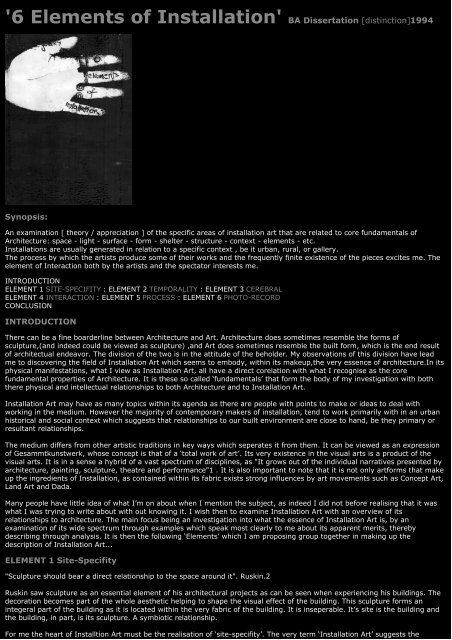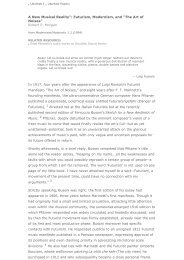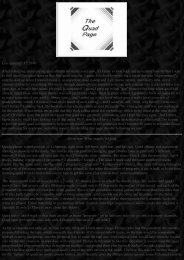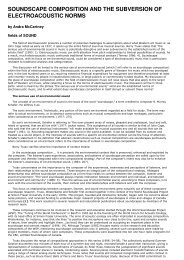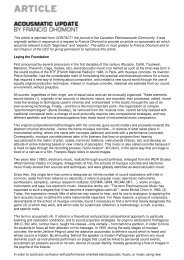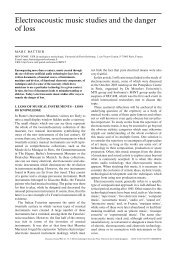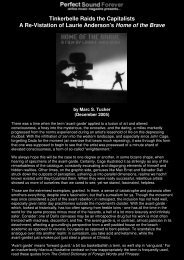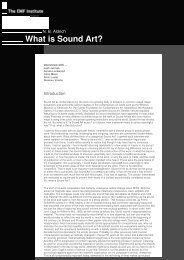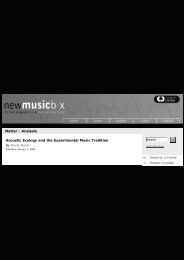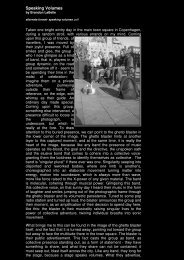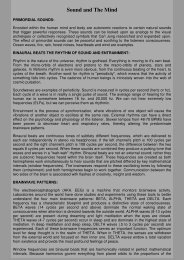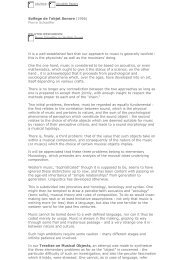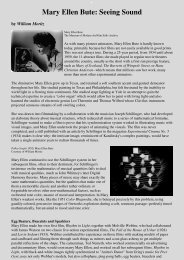Schaeffer_J-1994-6 Elements of Installation.pdf - An International ...
Schaeffer_J-1994-6 Elements of Installation.pdf - An International ...
Schaeffer_J-1994-6 Elements of Installation.pdf - An International ...
- No tags were found...
Create successful ePaper yourself
Turn your PDF publications into a flip-book with our unique Google optimized e-Paper software.
<strong>of</strong> the soild being a physical version <strong>of</strong> the space that was once contained by a now missing shell, a negative embodiement <strong>of</strong>space. It really is a ‘space-object’, it materialises the immaterial. David Thorpe described it perfectly in his response toHouse,"If you imagine having your mouth full <strong>of</strong> marbles or cotton wool, you have a physical sensation <strong>of</strong> the volume insideyour mouth"9.I remember seeing, ‘She came in Through the Bathroom Window’ (1.8), by Richard Wilson, during the time <strong>of</strong> its existence in1989,(on telly I think). It must have been one <strong>of</strong> the first contemporary installations that I saw. I remember half thinking thatthe idea <strong>of</strong> going to all the effort <strong>of</strong> displacing the window plane was odd yet fantastic. Its purpose was itself. Bringing outsideinside, but not really. It meant something to me. Especially as it dealt with architectural elements. The important point is itsdealing with space, it extrudes it. The play <strong>of</strong> the installation in the usage <strong>of</strong> architectural metaphor. You enter the building asyou would always do, then as you enter the space the installation reveals its self not just through its physical presence butthrough oddity. It makes you think about the function <strong>of</strong> buidings. You can not escape the fact that the glazing unit is itself theoriginal. You mentally relate it to its former location which in turn tells tou about its present location. Very simple, very strong.The element <strong>of</strong> light is brought to bear on this theme <strong>of</strong> glazing in, ‘Natchland’ (1.9) by Kazuo Katse at Gallery Wanda Reiff inMaastrict,1990. Katse deals with the negative <strong>of</strong> light reflected through an ordinary window in the gallery, (as with the negativespace <strong>of</strong> House). It is the memory <strong>of</strong> the light which exists painted on the floor .The paint though is black suggesting shadownot light, yet the image is not <strong>of</strong> shadow, it is the memory <strong>of</strong> light. It is almost as though it is the memory <strong>of</strong> night casting anegative night light. The work is <strong>of</strong> a philosophical nature but is displayed as part <strong>of</strong> the gallery. It is installed in relation to thespecific environment, being painted onto it as it is. Sculpture talks visually about light and shadow, among other elements,whereas illustrated by ‘Natchland’, installation communicates this quality but in relation to a specific light source. The controlledlight <strong>of</strong> the defined environment.The work <strong>of</strong> Gordon Matta-Clark opened my eyes to the world <strong>of</strong> <strong>Installation</strong> Art. After visiting the Serpentine show (summer93) I realised that the shear energy exposed in his work was what Art was all about for me. The creation <strong>of</strong> an objective. This isall about process,(see Element 5). What Matta-Clark achieves in his works is the revealing <strong>of</strong> new unthought <strong>of</strong> spaces inderelict buildings. He trained as an architect but gave it up in order to fulfill his experimental dreams. He invented his ownartform which he called <strong>An</strong>architecture, working with existing architecture and in a sense deconstructing it to reveal newrelationships within the building, what I would suggest was ‘installing new space’ within the existing fabric. Interpretingbuildings in a way not usually experienced. Take ‘Bronx Floors:Double Doors’(1.10) for example,made in 1973. Using a derelicthouse in the Bronx, New York, Matta-Clark set about remmovig the floors around both the enterances to a doorway. In doingso he transformed the spatial relationships which directly associuated themseles with that door. In ‘Splitting’ (1.11), probobalyhis best known work, he sawed a house in two, opening up the house to the space in which it existed. In both <strong>of</strong> these workshe installed space into the building. His concern was with altering attitudes to buildings, "By undoing a building ...I open a state<strong>of</strong> enclosure which had been preconditioned not only by physical necessity but by the industry that proliferates suburban andurban boxes as a pretext for ensuring a passive isolated consummer"10.The same ideas are embodied in (what I presume was) an accidental ‘installation’ that I found in Hulme during its currentdestruction. In, ‘Construction Detail’11 (1.12), the creation <strong>of</strong> space in relation to its locality summed up my feelings about thedestruction <strong>of</strong> Hulme as we presently saw it. The divide as expressed in, ‘Desireline Intersect’, has here become a negativerepresentation <strong>of</strong> both the barrier and <strong>of</strong> the sadness at seeing it dying. The reinforcing bars acting as a link to the pastspanning the gap which then becomes a suggestion <strong>of</strong> time. The photograph becomes a memory and record <strong>of</strong> that feeling andobject accordingly (see Element 6).The practice <strong>of</strong> Art in the realm <strong>of</strong> <strong>Installation</strong>, as expressed through things existing just for the sake <strong>of</strong> existing, is exemplifiedby the work <strong>of</strong> Siah Armajani. His preoccupation was also with the division <strong>of</strong> sculpture and architecture (as explored byWhiteread and Matta-Clark). ‘Bridge over a Nice Triangular Tree’ (1.13),from 1970 fulfills the notion that the sculpture existsfor no other reason than to transport the participant along its route. This, ordinarily is the exact function <strong>of</strong> a bridge to spanover or traverse a barrier and thus allow us to overcome the physical existence <strong>of</strong> that barrier. A bridge in the ordinary sensehas a legitimate function as with the walkway <strong>of</strong> ’Construction Detail’. What Armajani’s bridge does though is negate thisreasoned functional aspect. Its only purpose is to transport us over a very small tree! In so doing we form a peronal andphysical relationship with that tree even though the tree itself is totally overwhelmed by the act <strong>of</strong> doing it. The wholeconstruction is related to the tree and tailored for it. It is almost an act <strong>of</strong> ceremony. A lot, or most art, is indeed produced forits own end. Each artist choosing their own way <strong>of</strong> expressing something important to them. I feel though that the attitude <strong>of</strong>,‘Bridge over a Nice Triangular Tree’, expresses this element with particular clarity.Bulgarian born Christo Javacheff is another <strong>of</strong> those artists whose work has a direct correlation with the sites he uses to bringhis work to life. His work relates to all the ‘<strong>Elements</strong>’ that I consider vital to the making <strong>of</strong> an <strong>Installation</strong>. In terms <strong>of</strong> its sitespecificity he works both in an urban context as with, ‘The Pont Neuf Wrapped’ (1.14), and in the tradition <strong>of</strong>, ‘Land Art’, withthe production <strong>of</strong>, ‘Wrapped Coast’ (1.15) (1969). Again the peice is its site. Christo carried out this enormous undertaking14.5 kilometers southeast <strong>of</strong> Sydney, Australia using one million square feet <strong>of</strong>synthetic woven fibre and 56 kilometers <strong>of</strong> rope.The works finite form is precisely dictated by the surface <strong>of</strong> the coast that it engulfs. It is the installation <strong>of</strong> material in itslocation which neccesitated its installational quality. He (and his 125 strong team <strong>of</strong> helpers) did not merely locate an object,as say a Henry Moore is located as part <strong>of</strong> a landscape, but worked with that landscape to physicaly transform its very self. Thistransformation then becoming the net result. The Temporal Element <strong>of</strong> the lifespan <strong>of</strong> Chriso’s works is just as an imporant part<strong>of</strong> its whole Which brings us to the consideration <strong>of</strong> time in forming another <strong>of</strong> <strong>Installation</strong> Arts important ingredients...ELEMENT 2 TEMPORALITY"A flower that blossoms for a single night does not to us seem any less lovely. Nor can I understand any better why the beautyand perfection <strong>of</strong> a work <strong>of</strong> art or <strong>of</strong> an intellectual achievement should loose its worth because <strong>of</strong> its temporal limitation",Freud.12Temporalality belongs to the element <strong>of</strong> Time. The space-time cosmos that all exists in. The world is a product <strong>of</strong> time. We seeourselves in a direct relationship with time, as our existence is frammed by time. Einsteins expressions <strong>of</strong> thought talked <strong>of</strong> themetaphysical notion that all time, past present and future exists within the same space, therefore space can be seen to be,
Time. In relation to this concept, Temporality defines itself as a finite embodiement <strong>of</strong> that space-time. ‘Temporal’ is a wordwhich implies a physical relationship to worldly things as opposed to the spiritual affairs <strong>of</strong> Metaphysics. ‘Temporary’ in its owndefinition talks <strong>of</strong> time as lasting for a limited period, or a defined fraction <strong>of</strong> that Time. Thus the two consummate theirrelationship and become one. As discussed in, ’Element 1’, Physics has shown that matter is born from the vacuum, (that isspace), which then becomes the physical representation <strong>of</strong> Temporality in my analysis. The property <strong>of</strong> Time will then be takento represent the metaphysical notion that it records itself within its own whole."How long is a piece <strong>of</strong> string?" <strong>An</strong>on. This classic phrase introduces the next ingredient to be mixed into the meltingpot. Thisbeing the philosophical consideration <strong>of</strong> the relationship <strong>of</strong> time to the temporal nature <strong>of</strong> some installational works. What doesthe image <strong>of</strong> the word itself conjour up about insallation? You can install something and leave it to exist for seconds, years,decades or for many lifetimes. It can be said that all matter has finite existence therefore everything is temporary, but I wishto talk about <strong>Installation</strong>al temporality, which, to me, suggests the link with hours, weeks and months rather than with years,decades and centuries.In terms <strong>of</strong> Christos work then, temporality becomes essential to the whole. The work itself is only allowed to exist for aforeseeable finite reality, and it is this which helps it to become what it is; a temporary installation. As noted by Marina Vaisey,"The final work questions the whole notion <strong>of</strong> permenance in art, for Christo’s vast environmental sculptures which take place inthe real world, have a deliberatly limited life, for a few days, at the most two weeks" 13. It is Christos installations that excitme, I love his wrapped sculptures, but these live on, and are <strong>of</strong> a human scale. Somehow I can relate better to his ‘massive’sculptures that no longer exist. You can look at memories, and perhaps have an experience <strong>of</strong> that event, but you know that itis now cast in past recorded time (history). This has a direct influence upon your attitude towards it.In the work <strong>of</strong> <strong>An</strong>dy Goldsworthy, I find a real sense <strong>of</strong> excitment. He, as with Christo, enters the many different fields <strong>of</strong>installation. The temporality found within his body <strong>of</strong> work is an expression <strong>of</strong> the cycle <strong>of</strong> nature which is itself a ‘repetitivecycle <strong>of</strong> temporality’.Goldsworthy engages nature on its homeground, working with it to define its beauty, by exposing it through his transitionalprocess. What defines longevity in his work is the work itself. If the materials he uses to produce a piece are stone then it maywell last for years, but if that material is snow on a hill, or sand on a beach,then its lifespan may be days or hours.In the late winter <strong>of</strong> 1988/89, Goldsworthy made eighteen large snowballs (2.1) in Perthshire and then preserved them in coldstorage until July that summer where they were displayed in the Old Museum <strong>of</strong> Transport, Glasgow. There they were laid inline to live out there life. It took a total <strong>of</strong> five days for them to melt, slowly revealing there individual contents throughout thattime, as each snowball was blended with a different element from nature, such as fresh pine needles, or wilowherb stalks."When snow melts things hidden away emerge - evidence <strong>of</strong> time laid on the ground"14. It is this ‘evidence <strong>of</strong> time’ which thepiece deals with, both in terms <strong>of</strong> its manufacture and its temporality. When allowed to react with the summer heat thesnowballs both come alive and begin to die at the same time. Their destiny is determined. The work only exists as it fadesaway. You can visably see the passing <strong>of</strong> time as recorded by their dematerialisation. This is as important to the work as itsprocess.Five days is temporary, and so is 1/60th <strong>of</strong> a second, the rough shutter speed <strong>of</strong> the camera that caught Goldsworthy’sinstallations in space-time when creating, ‘Hazel stick throws’ (2.2), in 1980. Here he created a multitude <strong>of</strong> mini-installationswith each throw <strong>of</strong> the sticks that he made. This is so because the camera only happened to catch just one <strong>of</strong> thesemini-installations, which by implication means that it didn’t catch all the other exact co-ordinates <strong>of</strong> the sticks as they flewthrough gravitational space on their return journey to the ground. This ‘sculpture’ has at its core a real element <strong>of</strong> built inobselecence. There is no way (‘on earth’!) that this fraction in time could set out to be anything but temporary. This is thenperhaps an example <strong>of</strong> installation which is the epitome <strong>of</strong> temporality. Its very inception implies its immediate fate.This ‘built in obselecence’, is also instilled in Matta-Clarks work. The way he works with derelict buildings means that from thefirst touch or even the first thought his work is innevitably destined to be destroyed with the eventual transformation <strong>of</strong> thebuilding into rubble. His interaction with the building also adds to the temporance <strong>of</strong> that building as he frequently underminesits structural stability. He then is part <strong>of</strong> the demolition process, but in a controlled sense. In 1975 he was lucky enough to begiven permission to work with a building located adjacent to the Centre Georges Pompidou during its construction. He setabout burrowing through the walls and floors creating a ‘Conical Intersect’ (2.3) for the Paris Biennial. The house he worked onwas built in 1699 and was one <strong>of</strong> the last proporties due for demolition as part <strong>of</strong> the Pompidou modernizing programme <strong>of</strong> thePlateau Beauborg. The work was as provocative and controversoial as ever ensuring that all who encountered it were forcedinto thought.The same is true <strong>of</strong> Racheal Whitread’s ‘House’. It has been the reactions <strong>of</strong> the public which have helped bring it tointernational attention. Or at least it is these reactions which have made it so controversial. Now that it has been demolishedduring the writting <strong>of</strong> this dissertation it lies in the memory banks <strong>of</strong> society. For me, the destruction <strong>of</strong> ‘House’ was necessaryfor its completion. Many regard its destruction as a negative thing. Whiteread herself did not want it to be destroyed. From itsinception though it was always known that it was going to be destroyed (the role <strong>of</strong> process [Element 5]is important here), aswith a Matta-Clark work. This knowledge <strong>of</strong> its imminent death added to its worth in my opinion. It made people want to goand experience it before its removal. It heightened its existence, as its time was limited. Its temporality added to its ‘worth’, asit helped induce debate and thus its media coverage which brought it to a wider public.Architecture is something that is usually ‘built to last’, for economic reasons more than anything else. It is not usually seen astemporary. Having said this though ‘temporary’ architecture is designed and constructed. The reality <strong>of</strong> this though is that itstays put for much longer than intended. Vienna has a long tradition <strong>of</strong> building temporary structures that were intended toexist for a year or so but in reality have stayed put. Portacabins in schools solved accommadation problems quickly but havelasted well beyond their sell by date in actuality. Buildings are in fact temporal but not in the sense <strong>of</strong> <strong>Installation</strong>altemporality.Temporality can then add to the experience <strong>of</strong> <strong>Installation</strong> Art.It can be a singular part <strong>of</strong> the whole, or the whole itself. I findits gives a real sense <strong>of</strong> excitement to the process <strong>of</strong> involvement in installation. It also excites me when observing the records<strong>of</strong> past temporary installations. The very knowledge that they no longer exist I feel still adds a real sense involvement to theexperience <strong>of</strong> discovering their past history.ELEMENT 3 CEREBRAL
esponse to the work. A group <strong>of</strong> childern turned up not knowing its origins and jumped in the hole and climed all over it. Theythought that it was a real excavation and a real cottage and couldn’t understand the notion <strong>of</strong> it as art once the secret hadbeen revealed to them. Their ‘attitude’ to it was different to mine. One couple walking the family dog stopped to wonder, butthe wife seemed to be scared <strong>of</strong> it as she went <strong>of</strong>f to wait up ahead while the husband really started to question its existence.He tried to get his wife to come back but she refused point blank.In a way this transplantation resembles Duchamps ‘fountain’,yet it is very different. For a start it is not gallery based. and it isa much more involved exercise than the ‘readymade’. It questions society and its relationship to architecture. In two hunderedyears time, will tourists flock to our council estates in order to glory at the quaint rural architecture <strong>of</strong> the late twentiethcentury?What installation talks about to me through its cerebral element is not ideas such as the bounderies <strong>of</strong> art, as with Duchamp,but the qualities <strong>of</strong> the ‘<strong>Elements</strong>’ that I am discussing in this analysis. The proporties <strong>of</strong> what I view as ‘the fundamentals <strong>of</strong>architectural consideration’. These being philosophical issues, and physical elements such as Light, Space, Structure, Surface,Context, Form and Interaction etc. It is on this plane <strong>of</strong> thought that it interacts with my mind. This is what I see as its cerebralelement. It describes its own philosophical concepts through its physical narrative. The thought is in a sense an interaction <strong>of</strong>the mind and it is this ‘interaction ‘ which I wish to consider next.ELEMENT 4 INTERACTION"The spectator, who in the act <strong>of</strong> experiencing the work, acts as catalyst and receptor"18. Interaction is a part <strong>of</strong> everybody’sday to day life. It could be said that all <strong>of</strong> our own personal environments are living examples <strong>of</strong> installation. These may not beclassified as art, but nevertheless they are continually changing, and thus temporal in nature, and each is tailored to it site,that being the architecture container, within which, each is created. This was expressed by an artist called Collette in a workentitled ‘My Living Environment’ (4.1),produced in New York over a number <strong>of</strong> years, as she explains; "From 1970 to 1982 Ilived as a work <strong>of</strong> art, in a work <strong>of</strong> art - my living environment..."19. This statement, alters the emphasise <strong>of</strong> the act <strong>of</strong> ‘living’,and turns it into an artistic reality. Our perception is altered by Colette’s perception.In terms <strong>of</strong> <strong>Installation</strong> Art throughout this century, Interaction, on both the physical and cerebral level, has had an importantpart to play in terms <strong>of</strong> its own genetic make-up. The making <strong>of</strong> art has <strong>of</strong>ten migrated from the gallery to interact or intervenewith the outside world on its own terms. It may be the physical scale and presence <strong>of</strong> a work which forces the observer to notonly observe but to actually exist with in it or as part <strong>of</strong> it. This is the case with the earth-work installation, ‘Double Negative’(4.2) by Michael Heizer in the Nevada desert <strong>of</strong> 1969. The two forty foot by one hundered foot slots which were cut into theslopes means that, due to their enormous size and location, the only way <strong>of</strong> physically experiencing the work is to inhabit it likethe way we think <strong>of</strong> ourselves as inhabiting the space <strong>of</strong> our own bodies. Yet as it is a mirror image it makes us look and relatedirectly to our own postion. We can see ourselves disslocated from the solipsism by the nature <strong>of</strong> its duality. The opposing ‘self’(or slot) on the other side <strong>of</strong> the revine enables us to conceive the notion that we are standing looking at our own image as akind <strong>of</strong> ‘out <strong>of</strong> body’ experience. So it is the very involvement or interaction within ‘Double Negative’ which brings about itsmeaning. Even if that interaction is a cerebral one, as with you or I. We are still able, I believe, to transport our mind (andhence imaginary body) into that void through thought travel, and gain some notion <strong>of</strong> its ‘reality relation’(the real physicalversion <strong>of</strong> ‘Double Negative’, as opposed to the imagined one constructed on your mental monitor from its visualrepresentation, the photo).This same scale <strong>of</strong> interaction will be a necessity with the future completion <strong>of</strong> James Turrell’s grand project, ‘Roden Crater’(4.3) a volcanoe on the edge <strong>of</strong> the Painted Dessert, America. Turrell is currently working on, or with to be more exact this vastcrater overlooking the dessert. He is creating a multitude <strong>of</strong> spaces within which certain perceptions <strong>of</strong> the cosmos can beviewed. It is not the manipulation <strong>of</strong> the crater which is important to him, it is what it facilitates that is important."I wanted [tocreate] an area where you had a sense <strong>of</strong> standing on the planet. I wanted an area <strong>of</strong> exposed geology.....where you could feelgeologic time. Then in this stage set <strong>of</strong> geologic time, I wanted to make spaces that engaged celestial events in light so thatthe spaces performed a ‘music <strong>of</strong> the spheres’ in light"20. Turrell is trying to combine our experiences with those <strong>of</strong> the locatedcrater in a joint interaction with the light and cosmos <strong>of</strong> the universe. A very powerful notion. Turrells work has stemmed fromhis scientific background and a life long devotion to the experiencing <strong>of</strong> light. The qualities <strong>of</strong> the cerebral interaction whichwere evoked by ‘Double Negative’ are central to Turrells own definitions <strong>of</strong> thought, as he explains, "Firstly I am dealing withno object. Perception is the object. Secondly, I am dealing with no image, because I want to avoid associative, symbolicthought. Thirdly, I am dealing with no focus or particular place to look. With no object, no image, and no focus, what are youlooking at? You are looking at you looking. This is in response to your seeing and the self-reflective act <strong>of</strong> seeing yourself see.You can extend feeling out through the eyes to touch with seeing"21.Turrell’s most recent work was the light sensory chamber titled ‘Gasworks’(4.4) built at Dean Clough gallery near Leeds. This isa true interactively sensational experience. The machine is comprised <strong>of</strong> a metal sphere containing light emmitting gear with aconveyor belt leading into it. The person using it is conveyed into the sphere head first by a technician and then subjected to15 minutes <strong>of</strong> visual sensual overload consisting <strong>of</strong> coloured lights and strobes. Turrell had to have it checked by an eminentphsychoanalyst to make sure that it wasn’t going to harm anyone mentally. The purpose <strong>of</strong> it is to transport the participant intoanother dimension. The machine is just that and exists only to be interacted with by humans. Without interaction <strong>of</strong> thephysical and perceptual kind this machine would be redundant, purposeless. It is not the idea that counts here it is theexperience.This visual focus is the essential component <strong>of</strong> my next example. It is the actuality <strong>of</strong> the participant being the catalyst and thereceptor at the same time which is embodied within Bruce Neuman’s 1970 installation, ‘Corridor’ (4.5). It is the ‘idea’ and the‘action’ which combine to make the whole this time.(It even made the front cover <strong>of</strong> a Rosalind Krauss book!). The work is onlya tool waiting to be used as with Turrell’s sensory chamber. When approaching the television screens at the end <strong>of</strong> the‘coddidor’ the viewer becomes the installation as their image appears on the screen via the video camera mounted high upbehind them. As they approach the screens their image receeds. The closer they come to their own ‘reflection’ the smaller theyget. The images <strong>of</strong> these interactions with the corridor are recored as memory <strong>of</strong> the encounters.The only intended memory <strong>of</strong> interaction concearning Ron Hasseldon’s ‘Beldevere’ (4.6) installation in a forest is in the brain’s‘Hippocampus zone’ (the momory storage region <strong>of</strong> the human brain, first pictured in 1991). Hasseldon constructed a hugescaffolding structure in a forest in Dartmoor that allowed the viewer to climb to the top <strong>of</strong> the tree canopy and see the forestfrom an unaccustomed vantage point. Again this is a manufactured object which encourages the individual to interact with it to
<strong>Installation</strong> Art is an ever mutating Art form which refuses to have confines placed on it and therfore is difficult to pin down. Itis this characteristic which is so refreshing to the audience. I suggest that it will continue to mutate adding many more layersto its already richly decorated patina. It seems to be the ever dominante art form <strong>of</strong> the ninties and this I will suggest becomevery important in the future <strong>of</strong> the art history over the coming decades.FOOTNOTES:INTRODUCTION1. de Oliveria, Nicolas. ‘On <strong>Installation</strong>’;Oxley, Nicola. Art and Design, ‘<strong>Installation</strong> Art’issuePetry, Michael 1993, pp7ELEMENT 12. Ruskin, John. Quoted from lecture by Paul Hatton entitled‘Sculpture Object Space’ given at the Cornerhouse26/10/93.3. Krauss, Rosalind sculpture in the expanded field4. <strong>An</strong>dre, Carl. Quoted from lecture given by Peter Murray entitled,‘objects from the Sculpture Park.Givenat the Cornerhouse, 2/11/93.5. de Oliveria, Nicholas. op.cit. pp75a. Schaefer, Glen. Quoted from a lecture given by my dad atThe Study Society in March 1981 entitled ‘The Universe and the Mind <strong>of</strong> Man - Which the Reflector?’. ‘Universe with Man inMind’ 1981 pp36.5b. Schaefer, Glen. ibid.6. <strong>An</strong> installation by myself made in central Manchester september 937. Lippard, Lucy. Quoted by in, Six Years:The Dematerialisation <strong>of</strong>the Art Object. 1973 pp278. Quoted from The Late Show Thursday November 11th 19939. Thorpe, David. ‘Public Art/Art In Public’,Untitled winter93 pp510. Interview with Matta-Clark,Matta-Clark,ICC,<strong>An</strong>twerp,1977.11. Myself. Photograhic image <strong>of</strong> the level one walkway that used to link William Kent Crecent to John Nash crecent. July 1993.ELEMENT 2.12. Freud, Seigmund Quoted from an essay called,‘On Transience’written in november 1915 at the invitation <strong>of</strong> the Berlin GoetheSociety. First published in ‘Das Land Goethes 1914-16’.13. Vaizey, Marina. ‘Christo’ 1991 pp8.14. Goldsworthy, <strong>An</strong>dy. "Hand to Earth". 1990 pp116.ELEMENT 315. Holzer, Jenny. Interview for "Flash Art" supplement onConceptual Art Nov/Dec 91 pp112.16. Koons, Jeff. ibid pp113.17. lost the name. brochure from the information centre by theartist.ELEMENT 418. de Oliveria, Nicholas. op.cit. pp11.19. Wines, James. Quoted by Colette in "De-Architecture".1987 pp170.20. Turrell, James. "James Turrell - Air Mass".1993 pp5821. Turrell, James. ibid pp26.ELEMENT 522. Goldsworhty, <strong>An</strong>dy. "Hand to Earth". Quoted originaliy from‘Laws’ 1988 pp44.23. Cage, John. "<strong>Installation</strong> Art" introduction "towardsinstallation" <strong>1994</strong> pp26.24. Goldsworthy, <strong>An</strong>dy. "Hand to Earth" interview with JohnFowles 1987 pp162.ELEMENT 625. Sontag, Susan. "On Photography" pp154 1977.26. Postman, Niel "Amusing Ourselves To Death" pp72 1986.27. Jones,K "British Journal Of Aesthetics" Autumn 1983 articleentitled ‘The Metaphisics Of The Photograph’ pp375.28. Goldsworthy, <strong>An</strong>dy op.cit. pp929. <strong>An</strong>on.ILLUSTRATIONSSITE-SPECIFITY¬ ‘Sculpture’ Naum Gabo. 1954.¬ ‘The Villa Savoy’ Le Corbusier.¬ ‘Proun Environment’ El Lissitsky. 1923.¬ ‘Merzbau’ Kurt Shwitters 1923
¬ ‘Untitled’ Mona Hatoum. 1992.¬ ‘Desireline Intersect’ Janek. 1993.¬ ‘House’ Rachael Whiteread. 1993.¬ ‘She came in Through the Bathroom Window’ Richard Wilson.1989.¬ ‘Natchland’ Kazuo Katse. 1990.¬‘Bronx Floors:Double Doors’ Gordon Matta-Clark. 1973.¬‘Splitting’ Gordon Matta-Clark. 1974.¬ ‘Construction Detail’ Janek. 1993.¬ ‘Bridge over a Nice Triangular Tree’ Siah Armajani. 1970.¬ ‘The Pont Neuf Wrapped’ Christo Javacheff. 1985.¬ ‘Wrapped Coast’ Christo Javacheff. 1969.TEMPORALITY¬ ‘Snow Balls in Winter’ <strong>An</strong>dy Goldsworthy. 1989.¬ ‘Hazel Stick Throws’ <strong>An</strong>dy Goldsworthy. 1980.¬ ‘Conical Intersect’ Gordon Matta-Clark. 1973.CEREBRAL¬ ‘Fountain’ Marcel Duchamp. 1917. (Original lost!)¬ ‘Lever’ Carl <strong>An</strong>dre. 1972.¬ ‘The complete works <strong>of</strong> Jane Austin’ Meg Cranston 1991.¬ ‘Piltdown Bungalow’ 1993.INTERACTION¬ ‘My Living Environment’ Collette. 1970-82.¬ ‘Double Negative’ Michael Heizer. 1969.¬ ‘Roden Crater’ James Turrell. 1983¬ ‘Gasworks’ James Turrell 1993.¬ ‘Corridor’ Bruce Neuman. 1970.¬ ‘Beldevere’ Ron Hasseldon. 1987.¬ ‘44 Bonner Rd’ Francis Cape. 1993.¬ ‘Shadow Piece’ Nat Goodden. 1972.PROCESS¬‘In and out <strong>of</strong> love’ Damien Hirst. 1991.¬‘Dry walk’ Richard Long. 1989.¬‘A Line made by walking’ Richard Long. 1967¬‘Floating hole’ <strong>An</strong>dy Golsworthy. 1984.¬‘Horse chestnut stalks and thorns’ <strong>An</strong>dy Goldsworthy. 1989¬‘49,390 cubic feet packaged’ Christo. 1966.¬‘Field for the British Isles’ <strong>An</strong>tony Gormley. <strong>1994</strong>.PHOTO-RECORD¬‘The threat <strong>of</strong> serenity’ Günther Förg. 1993.¬‘Bus Shelters’ Dennis Adams.¬‘La Felure, au Choeur des corps’ Genevieve Cadieux. 1990.¬‘The way it was’ Alfredo Jaar. 1990.¬‘Neighbours’ Janek. 1992.BIBLIOGRAPHY1. Art @ Design. <strong>Installation</strong> Art 19932. Sharpe, R.A. Contempoprary Aesthetics 19833. Kennick, W.E. Art and Phiolsophy 19644. Various. Double Take, collective memory and current art 19925. Henry Moore Inst. Hand To Earth 19916. Goldsworthy,A. Rain Sun Snow Hail Mist Calm 19857. Foster,H. Discussions in Contemporary Culture 19878. Prentice-Hall. Photographers on Photography 19669. Archer,M. <strong>Installation</strong> Art <strong>1994</strong>10. South Bank. Walking in Circles 199111. Serpentine. Gordon Matta-Clark 199312. Vaisey,M. Christo 199113. Krauss,R,E. Passages in Modern Sculpture 197714. South Bank. James Turrell 199315. Wines,J. De-Architecture 198716. Stolintz, J. Aesthetics 1965ARTICLES/JOURNALS1. Untitled (ARTS NEWSPAPER) various issues 93/42. The Face Jenny Holzer Oct933. The British Journal <strong>of</strong> Aesthetics. Warburton,N. Spring 19884. "Das Land Goethes 1914/16" Freud,S.5. The British Journal <strong>of</strong> Aesthetics. Jones,K. Autumn 1985LECTURES"Sculpture Object Space" Lecture series held at the CornerhouseSeptember to December 1993.ACKNOWLEDGEMENTS
Thanks to Daniel and Richard for their guiding minds,and to everything and everyone who make me laugh.Laughter is the saviour <strong>of</strong> sanity.Dedicated to the spirit <strong>of</strong> Jill Regan who diverted me onto the right path.Copyright <strong>of</strong> audiOh!Room <strong>1994</strong>. JANEK SCHAEFER


